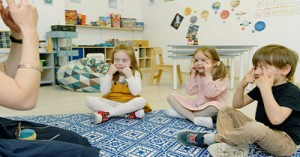A service assessment and rating visit is an opportunity to demonstrate the strengths of your service and seek user feedback. It is important to be able to articulate your achievements and practices effectively. The following article provides information on Supporting Educators During The Assessment and Rating Process, Providing Opportunites For Articulation, Using The Right Langauge, Reflecting On Practice and more.
Supporting Educators
The deeper your educators’ familiarity with approved learning outcomes and methods, the better they will be able to discuss how their own practice is meeting standards. Support your educators to gain a thorough understanding of the NQS, the relevant Approved Learning Framework/s and your Quality Improvement Plan. Hold regular meetings, reflective sessions and, if relevant, professional development workshops to discuss these topics.
Provide Opportunities For Articulation
Discussing practice is what you do when you talk with and about children and their knowledge, strengths, ideas, culture, abilities and interests. You discuss with other educators, staff and parents the children’s learning, their social and emotional development, wellbeing, and friendships. In this sense, though educators are discussing practice on a daily basis, it is important they are able to articulate it effectively – this means discussing not just the ‘what’ of your service philosophy but also the ‘how’ and ‘why’. To help your educators get used to this:
- include ‘quality practice’ and ‘reflective practice’ as regular agenda items in team meetings and discussions with parents
- use reflective questions in the Guide to the NQF as cues to start discussions
- use techniques such as brainstorming or mind mapping to document how practices are matching up against Standard or Elements of the NQS and other regulatory guidelines.
Use The Right Language
When discussing practice during an assessment and rating visit, ensure that your educators and staff use words and expressions that refer to the language of the NQS. This would not only prove that your educators are familiar with the NQS it also shows that your service understands and is committed to quality outcomes. Also support your educators to demonstrate the collaborative approach with expressions like:
- “Families were able to share their thoughts through…”
- “After the team reflected on this feedback we changed the way we…”
- “The children share their ideas by…”
The more frequently your service and educators use the above tips in your service, the better prepared you will be to discuss practice at assessment and rating visits.
Reflect On The Whys and Hows Of Practice
The key to articulating practice is to have a very clear understanding of not just what you are teaching but why and how. Reflect on your service’s learning outcomes and practices so that you are able to articulate your service philosophy and how it is implemented. Some cues for reflection could be:
- Does your service believe in a play-based or emergent curriculum?
- Is the curriculum a blend of different subjects or philosophies?
- How does your service’s approach compare with others?
At the same time, reflect on your own beliefs, attitudes and values that inform your teaching approach. Educators like everyone else are products of a complex interweaving of family background, environment, education, community and experiences. Ask yourself:
- How do you prepare for discussion of programs, practices and policies with families, other educators and an authorised officer?
- The intent behind your practice and the ways it contributes to quality outcomes for children?
- Where within your service you can seek help to develop your articulation skills
- How you can support your coworkers to develop their own articulation skills?
Ensure Continuous Self-Assessment
If your educators and service are already engaged in a continuous process of self-assessment, they will be better prepared to discuss with the authorised assessor about practice, compliance with regulatory standards and areas of improvement. Jumpstart the self-assessment process by adopting the assessor’s perspective so that your service and educators can identify what an authorised assessor might observe, discuss or sight about the quality of your service practices and programs. For example, when discussing Quality Area 3.1.1 the assessor might want to know in what ways the environment is planned and organised, taking into consideration the need for safe, yet challenging spaces. Likewise, when discussing Quality Area 3.2.3, they might ask, how children and educators are supported to engage with and respect the natural environment on a regular basis.
Check out the following for many such examples of what authorised assessors may observe, discuss and sight for each of the quality areas. How To Achieve Each Quality Area
Reference:
Tips For Discussing Practice At An Assessment and Rating Visit, ACECQA
Guide To The NQF, ACECQA







 As an Educator in Australia, your pay rate falls under the Children’s Services Award 2010. This award states the minimum amount that an employer can
As an Educator in Australia, your pay rate falls under the Children’s Services Award 2010. This award states the minimum amount that an employer can When working as a qualified Early Childhood Teacher (with a university degree) within a service, your rate of pay will come from the Educational Services
When working as a qualified Early Childhood Teacher (with a university degree) within a service, your rate of pay will come from the Educational Services When working as a Diploma Qualified Educator your pay rate is from the Children's Services Award 2010. This Award states your minimum rate of pay
When working as a Diploma Qualified Educator your pay rate is from the Children's Services Award 2010. This Award states your minimum rate of pay When working as a Cert 3 Qualified Educator, your pay rate is from the Children's Services Award 2010. This Award states your minimum rate of
When working as a Cert 3 Qualified Educator, your pay rate is from the Children's Services Award 2010. This Award states your minimum rate of Educational Leaders play a crucial role in their early childhood service by ensuring that the educational program aligns with best practices and supports the holistic
Educational Leaders play a crucial role in their early childhood service by ensuring that the educational program aligns with best practices and supports the holistic In early childhood education and care, ratios are more than a technicality—they are a frontline safeguard. Every child deserves responsive supervision, emotional connection, and developmental
In early childhood education and care, ratios are more than a technicality—they are a frontline safeguard. Every child deserves responsive supervision, emotional connection, and developmental Here’s a comprehensive Mobile Phone and Smart Watch Policy tailored for early childhood education and care (ECEC) services in Australia, aligned with the latest 2025
Here’s a comprehensive Mobile Phone and Smart Watch Policy tailored for early childhood education and care (ECEC) services in Australia, aligned with the latest 2025 With the new national child safety reforms kicking in on 1 September 2025, early childhood services like yours have a real opportunity to lead the
With the new national child safety reforms kicking in on 1 September 2025, early childhood services like yours have a real opportunity to lead the The Sea of Fish Challenge is a national initiative that invites children, educators, families, and communities to create and display fish artworks as a symbol
The Sea of Fish Challenge is a national initiative that invites children, educators, families, and communities to create and display fish artworks as a symbol Across the early childhood education and care sector, educators are sounding the alarm: current staffing ratios are insufficient to deliver safe, meaningful, and developmentally appropriate
Across the early childhood education and care sector, educators are sounding the alarm: current staffing ratios are insufficient to deliver safe, meaningful, and developmentally appropriate


